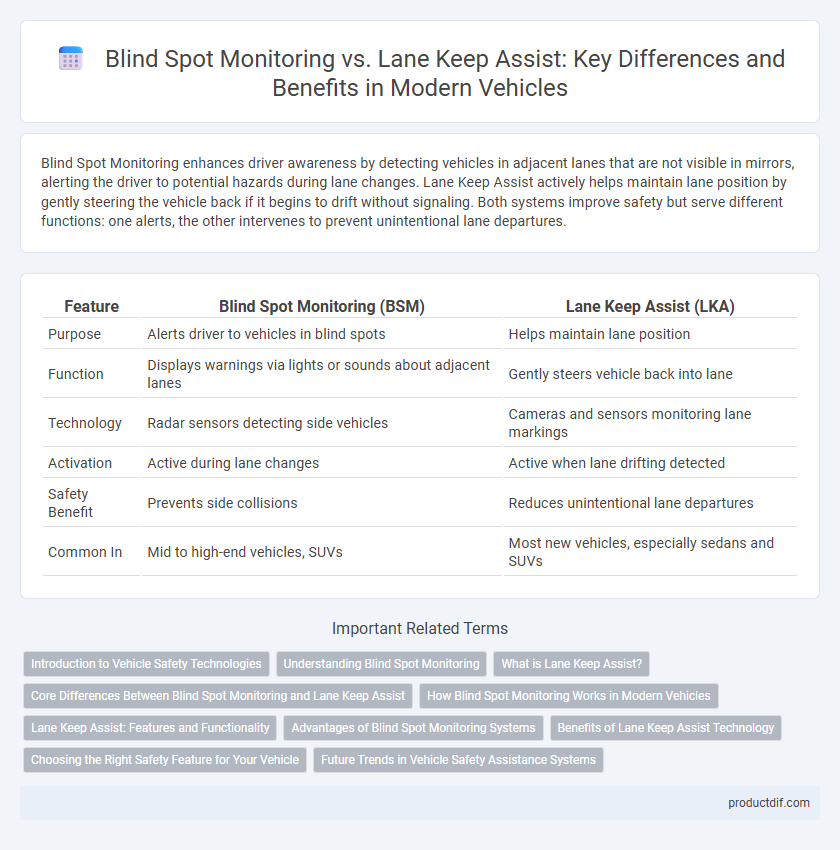Blind Spot Monitoring enhances driver awareness by detecting vehicles in adjacent lanes that are not visible in mirrors, alerting the driver to potential hazards during lane changes. Lane Keep Assist actively helps maintain lane position by gently steering the vehicle back if it begins to drift without signaling. Both systems improve safety but serve different functions: one alerts, the other intervenes to prevent unintentional lane departures.
Table of Comparison
| Feature | Blind Spot Monitoring (BSM) | Lane Keep Assist (LKA) |
|---|---|---|
| Purpose | Alerts driver to vehicles in blind spots | Helps maintain lane position |
| Function | Displays warnings via lights or sounds about adjacent lanes | Gently steers vehicle back into lane |
| Technology | Radar sensors detecting side vehicles | Cameras and sensors monitoring lane markings |
| Activation | Active during lane changes | Active when lane drifting detected |
| Safety Benefit | Prevents side collisions | Reduces unintentional lane departures |
| Common In | Mid to high-end vehicles, SUVs | Most new vehicles, especially sedans and SUVs |
Introduction to Vehicle Safety Technologies
Blind Spot Monitoring uses radar sensors to detect vehicles in adjacent lanes, alerting drivers to potential hazards during lane changes. Lane Keep Assist employs cameras and steering control to help maintain lane position, reducing the risk of unintentional drifting. Both technologies enhance overall vehicle safety by addressing common causes of accidents related to driver awareness and lane departure.
Understanding Blind Spot Monitoring
Blind Spot Monitoring uses radar sensors to detect vehicles in adjacent lanes that may not be visible in side mirrors, alerting drivers with visual or audible signals. This system enhances safety by reducing the risk of collisions during lane changes, especially on highways. Unlike Lane Keep Assist, which actively steers the vehicle to maintain lane position, Blind Spot Monitoring serves as a crucial warning system without interfering with steering control.
What is Lane Keep Assist?
Lane Keep Assist (LKA) is an advanced driver-assistance system designed to help maintain a vehicle's position within its lane by detecting lane markings using cameras and sensors. It provides gentle steering inputs or alerts to prevent unintentional lane departures, enhancing safety on highways and busy roads. LKA differs from Blind Spot Monitoring by actively controlling steering, whereas Blind Spot Monitoring only alerts drivers of vehicles in adjacent lanes.
Core Differences Between Blind Spot Monitoring and Lane Keep Assist
Blind Spot Monitoring alerts drivers to vehicles in adjacent lanes that may not be visible, enhancing situational awareness during lane changes. Lane Keep Assist actively intervenes by gently steering the vehicle back into the lane if it detects unintentional drifting, promoting lane discipline. The core difference lies in Blind Spot Monitoring providing warnings, while Lane Keep Assist offers corrective steering control for lane maintenance.
How Blind Spot Monitoring Works in Modern Vehicles
Blind Spot Monitoring in modern vehicles uses radar sensors or cameras mounted on the side and rear to detect objects in adjacent lanes that are not visible in the driver's side or rearview mirrors. When a vehicle is detected in the blind spot, the system alerts the driver through visual indicators on the side mirrors, audible warnings, or haptic feedback. This technology enhances driving safety by reducing lane-change collisions and increasing driver awareness of surrounding traffic conditions.
Lane Keep Assist: Features and Functionality
Lane Keep Assist utilizes cameras and sensors to detect lane markings and provides steering input to help keep the vehicle centered within the lane, enhancing safety by reducing unintentional lane departures. This advanced driver-assistance system activates when the vehicle begins to drift without signaling and can often offer corrective steering or alerts to prevent accidents. Integrating with adaptive cruise control and other safety features, Lane Keep Assist contributes significantly to semi-autonomous driving capabilities and overall road safety.
Advantages of Blind Spot Monitoring Systems
Blind Spot Monitoring systems enhance driver awareness by detecting vehicles in adjacent lanes that may not be visible through side mirrors, reducing the risk of side collisions during lane changes. These systems use radar or ultrasonic sensors to provide real-time alerts, allowing drivers to react promptly to potential hazards. Compared to Lane Keep Assist, Blind Spot Monitoring offers critical safety benefits by specifically targeting unseen areas, improving overall road safety during multi-lane driving.
Benefits of Lane Keep Assist Technology
Lane Keep Assist technology enhances vehicle safety by actively steering the car back into its lane when unintentional drifting is detected, significantly reducing the risk of side collisions. This system supports driver awareness and reduces fatigue by maintaining lane discipline, especially during long highway drives. By providing corrective steering inputs, Lane Keep Assist helps prevent accidents caused by inattentive or drowsy driving, offering a proactive layer of protection beyond what Blind Spot Monitoring provides.
Choosing the Right Safety Feature for Your Vehicle
Blind Spot Monitoring uses radar sensors to detect vehicles in adjacent lanes, alerting drivers to hidden dangers during lane changes, while Lane Keep Assist employs cameras to monitor lane markings and gently steers the vehicle back if it drifts unintentionally. Selecting the right safety feature depends on your driving habits and environment; Blind Spot Monitoring is ideal for highway and urban traffic with frequent lane changes, whereas Lane Keep Assist enhances safety on highways by preventing unintentional lane departures. Prioritize systems with high safety ratings and compatibility with your vehicle's existing technology for optimal performance.
Future Trends in Vehicle Safety Assistance Systems
Blind Spot Monitoring (BSM) and Lane Keep Assist (LKA) are evolving rapidly with advancements in sensor fusion and artificial intelligence, enhancing real-time detection accuracy and response times. Future vehicle safety assistance systems will integrate these technologies with V2X (Vehicle-to-Everything) communication, allowing cars to share blind spot and lane data for cooperative maneuvering and accident prevention. Enhanced predictive analytics and adaptive algorithms will enable these systems to anticipate driver behavior and environmental changes, significantly reducing collision risks on increasingly complex roadways.
Blind Spot Monitoring vs Lane Keep Assist Infographic

 productdif.com
productdif.com